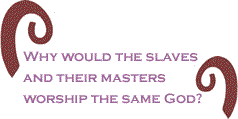
Why are television evangelists
or the corner fire-and-brimstone preachers we find on college
campuses and in  other places reprehensible
to many people who, themselves, attend Church on Sunday and consider
themselves pious? Whenever this issue comes up in class, my students
tell me that these preachers "give Christianity a bad name," and "do
not reflect true Christianity." What are we to make
of this? After all, the message that is promoted in established
churches and that is promoted in fringe denominations is basically
the same; what varies is the degree of a preacher's rhetorical
sensitivity (or lack thereof). Television evangelists, with their
extravagance, and the fire and brimstone preachers that stand on
our college campuses and harangue listeners are simply, in many
cases, not persuasive. Such religious leaders alienate potential
converts with their anger or superficiality, rather than encourage
people to join their community. In other words, we worship in
places where we feel most comfortable, indifferent to the fundamental
alienation of the ideology of religion. Our places of worship
tend to reflect our cultural and socio-economic backgrounds. other places reprehensible
to many people who, themselves, attend Church on Sunday and consider
themselves pious? Whenever this issue comes up in class, my students
tell me that these preachers "give Christianity a bad name," and "do
not reflect true Christianity." What are we to make
of this? After all, the message that is promoted in established
churches and that is promoted in fringe denominations is basically
the same; what varies is the degree of a preacher's rhetorical
sensitivity (or lack thereof). Television evangelists, with their
extravagance, and the fire and brimstone preachers that stand on
our college campuses and harangue listeners are simply, in many
cases, not persuasive. Such religious leaders alienate potential
converts with their anger or superficiality, rather than encourage
people to join their community. In other words, we worship in
places where we feel most comfortable, indifferent to the fundamental
alienation of the ideology of religion. Our places of worship
tend to reflect our cultural and socio-economic backgrounds. As an example of the above, it should be recalled
that both the slaves and the slave masters of the pre-Civil War
United States
worshipped Jesus Christ. In addition, freed, economically deprived
and racially segregated African-Americans still largely continue
to worship Jesus. How can this be? Why would the slaves and
their masters worship the same God? Why would Black people today,
who make up the most impoverished, imprisoned, and alienated of
our nation, continue to identify with the American God of wealth
and privilege?

There are many ways to answer the above question,
but one explanation seems particularly plausible – both groups
of people worship fundamentally different Christs. One
of the great successes of Christian doctrine has been its  malleability. Its
messages are general enough, its psychology sophisticated enough,
that differing groups of people can identify with it and adapt
it to meet their own needs. The same book (the Bible) justifies
both slavery and emancipation, misogyny and equality. How
a person interprets religious doctrine is a matter of perspective
and of community. The different sects that exist reflect the different
dimensions of perspective and the needs of different communities. Slave
owners needed to justify their slavery to their society, while
slaves, within the context of a slave owning society, needed to
evoke an image of their aspirations for freedom. Throughout much
of Latin America during the 1960s, 70s, and 80s, Liberation Theologians
evoked Jesus in the name of the struggling peasant class while
the rulers of the various Latin American countries slaughtered
peasants in the name of "protecting" Christianity. malleability. Its
messages are general enough, its psychology sophisticated enough,
that differing groups of people can identify with it and adapt
it to meet their own needs. The same book (the Bible) justifies
both slavery and emancipation, misogyny and equality. How
a person interprets religious doctrine is a matter of perspective
and of community. The different sects that exist reflect the different
dimensions of perspective and the needs of different communities. Slave
owners needed to justify their slavery to their society, while
slaves, within the context of a slave owning society, needed to
evoke an image of their aspirations for freedom. Throughout much
of Latin America during the 1960s, 70s, and 80s, Liberation Theologians
evoked Jesus in the name of the struggling peasant class while
the rulers of the various Latin American countries slaughtered
peasants in the name of "protecting" Christianity.
As further evidence for the claim that Christianity
adapts to the communities in which it is practiced, we can point
to the fact
that Jesus' image varies depending on the culture in which he is
worshipped. While he appears to most of us in Europe and in the
United States as a white man with blonde hair and blue eyes, that
image is considerably different in other cultures. For example,
in Chinese churches, Jesus appears Asiatic. In Africa, he appears
with African characteristics. (See Anton Wessels, Images of
Jesus: How Jesus is Perceived and Portrayed in Non-European Cultures,
Grand Rapids, MI: Wm B. Eerdmans Publishing, 1990.)

 As the above begins to illustrate, there is
a great deal of diversity and variance in a religion that claims
the terrain of timeless
historical truth. In the midst of all this variance, we like to
believe that somehow, our church, our religion, and our interpretation
are more real than those of the people down the street. It is
typical of human beings to moralize from their community experiences. Our
community involvements ground our knowledge commitments. Recognizing
this point helps us to realize that all of our institutional
practices, that is, our official connections with knowledge,
are idiosyncratic and are thus open to the charge of political
and moral inconsistency. As the above begins to illustrate, there is
a great deal of diversity and variance in a religion that claims
the terrain of timeless
historical truth. In the midst of all this variance, we like to
believe that somehow, our church, our religion, and our interpretation
are more real than those of the people down the street. It is
typical of human beings to moralize from their community experiences. Our
community involvements ground our knowledge commitments. Recognizing
this point helps us to realize that all of our institutional
practices, that is, our official connections with knowledge,
are idiosyncratic and are thus open to the charge of political
and moral inconsistency.
Omar Swartz is Assistant Professor, Department
of Communication, University of Colorado at Denver, A.B., 1989,
Humboldt State
University (cum laude); M.A., 1992, University of California,
Davis; Ph.D., 1995, Purdue University; J.D., 2001 (magna cum
laude), Duke University. |






